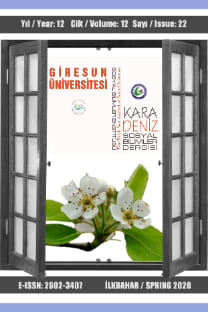Perge Batı Kapıdan Bir Heykel
Perge, Portre Heykel, Severuslar Hanedanlığı Dönemi, Alexander Severus Dönemi
A Statue from West Gate of Perge
___
- Albustanlıoğlu, T. (2006). Dokimeion ışığı altında Roma İmparatorluk döneminde mermer kullanımı: İmparatorluk yönetimindeki Anadolu mermer ocaklarının işletme stratejisi ve organizasyonu (Doktora Tezi). Ankara Üniversitesi Sosyal Bilimler Enstitüsü, Ankara.
- Altun, Ö. (2016). Geç Roma portreciliği (Doktora Tezi). Selçuk Üniversitesi Sosyal Bilimler Enstitüsü, Konya.
- Bergmann, M. (1977). Studien zum römischen porträt des 3. jahrhunderts n. Chr. Bonn: Rudolf Habelt Verlag Gmbh.
- Bernoulli, J. J. (1891). Römische ikonographie: Die bildnisse der römischen kaiser II. Von Galba bis Commodus. Stuttgart-Berlin-Leipzig: Union Deutsche Verlagsgesellschaft.
- Durugönül, S. (2021). Roma devlet kabartmalarında propaganda ve sanat. Ankara: Bilgin Kültür Sanat Yayınları.
- Fittschen, K. ve Zanker, P. (1985). Katalog der römischen porträts in den Capitolinischen Museen und den anderen kommunalen sammlungen der stadt Rom: Band I-text. West Germany: Philipp von Zabern-Mainz am Rhein.
- Fittschen, K. ve Zanker, P. (1985). Katalog der römischen porträts in den Capitolinischen Museen und den anderen kommunalen sammlungen der stadt Rom: Band I-tafeln. West Germany: Philipp von Zabern-Mainz am Rhein.
- Güven, B. A. (2014). Pamphylia Bölgesi Roma dönemi portreciliği (Doktora Tezi). İstanbul Üniversitesi Sosyal Bilimler Enstitüsü, İstanbul.
- Heintze, H. v. (1961). Römische porträt-plastik. Stuttgart: Hans E. Günther Verlag.
- Hinks, R. P. (1976). Greek and Roman portrait sculpture. London: British Museum Publications.
- İnan J. (1965). Antalya Bölgesi Roma devri portreleri: Römische porträts aus dem gebiet von Antalya. Ankara: Türk Tarih Kurumu Basımevi.
- İnan J. ve Rosenbaum E. (1966). Roman and early Byzantine portrait sculpture in Asia Minor. London: The Oxford University Press. Kleiner, D. E. E. (1992). Roman sculpture. New Haven-London: Yale University Press.
- Linfert, A. (1992). Die antiken sculpturen des musée municipal von château-gontier. Germany: Philipp von Zabern.
- Özgan, R. (2015). Roma portre sanatı III. İstanbul: Ege Yayınları.
- Poulsen, V. (1964). Römische bildwerke: Die blauen bücher. Münih-Stuttgart: F. Bruckmann K. G. - J. F. Steinkopf.
- Schröder, S. F. (1993). Katalog der antiken skulpturen des museo del prado in Madrid. Germany: Philipp von Zabern.
- Vermeule, C. C. (1981). Greek and Roman sculpture in America. London: University of California Press.
- Waelkens, M. (1982). Carriéres de marbre en Phrygie (Turquie). Bulletin des Musées d’Art d’Histoire, 53, 33-54.
- Wegner, M. (1939). Die herrscherbildnisse in antoninischer zeit. Berlin: Verlag Gebr. Mann.
- Wegner, M. (1956). Hadrian. Plotina. Matidia. Sabina. Berlin: Verlag Gebr. Mann.
- Wiggers, H. B. ve Wegner, M. (1971). Caracalla bis Balbinus. Berlin: Verlag Gebr. Mann.
- Wood, S. (1986). Roman portrait sculpture 217-260 A.D. Leiden: E. J. Brill.
- ISSN: 2602-3407
- Yayın Aralığı: Yılda 2 Sayı
- Başlangıç: 2009
- Yayıncı: -
Âşıkların Dilinden Kuşlar: Kuş Destanları (Karşılaştırmalı Bir İnceleme)
Konyalı Ermeniler ve Eğitim Faaliyetlerine Bir Bakış
Bütünleşik SV-CoCoSo Teknikleriyle Etkinlik Analizi: Mevduat Bankaları Gruplarında Bir Uygulama
Sağlık Hizmetlerinde Performans Kavramının Bibliyometrik Analizi
Berfin Sude İLDENİZ, Gülçin KARADENİZ
Şevket Rado’nun “Eşref Saat” Adlı Eserinin Söz Varlığı
Türkiye’de Dolarizasyonun Belirleyicileri
Otoriter Rejimlerin Aklanma Yöntemi Olarak Sportswashing: Suudi Arabistan Krallığı Örneği
Cem YÜCETÜRK, Yusuf Bahadir KESKİN
Menteşe Bölgesinde Eşkıyalık Olayları ve Nizama Aykırı Suçlar (1789-1808)
Suha Oğuz BAYTİMUR, İhsan ÖNCEL
Yeni Medya Ortamlarında Akıllı Telefonların Zaman Kavramı Bağlamında İncelenmesi
